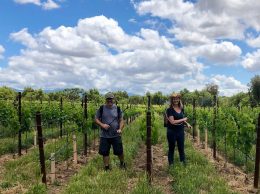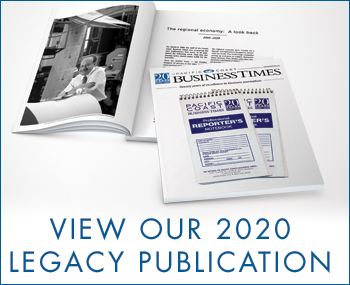After an epic 11-hour meeting, the San Luis Obispo County Board of Supervisors made the right decision when it voted 4-0 to impose a moratorium on new pumping in the Paso Robles groundwater basin.
The emergency restriction could last up to two years and only allows new pumping if it is offset by a 1-to-1 ratio. It’s designed to give county officials, vineyard owners and homeowners time to address the looming groundwater crisis in one of the epicenters of economic growth in the region. In recent years, homeowners and businesses have come into increasing conflict as water levels have dropped drastically.
There’s no denying that this move will hurt some individual businesses and have a stifling effect on economic growth in North San Luis Obispo County in the short term. But taking a time-out to find an orderly, permanent and equitable solution is far, far better than the alternative of years of costly litigation and what’s known as an adjudicated settlement.
In California, the state does not oversee groundwater. The users over the water have rights to it, and if disputes arise among them, there are two options: form a water management district to hash things out, or wait for lawsuits to roll in and let the courts adjudicate a settlement. Paso Robles need look no further than the Santa Maria Valley to see the drawbacks of adjudication. It took years of costly litigation for Santa Maria to work out an agreement, and the few farmers and landowners who fought to keep drawing more than their fair share ended up losing anyway.
In our view, there are two main reasons why taking a break to create a groundwater management district is a good idea.
• The lack of data. The San Luis Obispo Tribune did admirable work in a series of stories that laid out the problem clearly, but one thing that the work revealed is that there is a paucity of good data on how much water is being drawn, who is drawing it and how the balance between agriculture and urban uses has changed over time.
• Business needs certainty. An orderly process that leads to a clear and predictable price for water allows vineyards and potential investors to put solid numbers into their business plans.
The dispute over groundwater in Paso Robles is mostly a dispute over how much water will cost. Luckily, wine grapes resist price commoditization quite well. If water costs more, Paso Robles wines can target premium price brackets in order to make up the difference in a way that growers of other crops cannot.
In the meantime, it is well worth burning a few land speculators and throttling growth for a year or two to ensure the long-term viability of Paso Robles as a continued engine of economic success.






 Print
Print Email
Email


















I greatly appreciate your editorial entitled “Taking time out to avoid a Paso Robles water crisis”. I am a local Hydrogeologist with over 30 years of experience. My colleagues and I have developed technologies that could directly address some of the issues you’ve raised regarding lack of quality data. I will describe two of these below.
1) Groundwater Basin Storage Tracking (GBST) – We can use sensors placed in monitoring wells to rapidly determine the spatial distribution of water levels in real time. Results can automatically be posted on-line and be available on demand. Users can select any two times of interest and GBST reports the amount of volumetric change and the spatial distribution of the relative change in an easy to understand contour map (sometimes referred to as a “heat map”). Users can determine the amount of available groundwater supply at any time, as well as identify where trouble spots due to overdraft (e.g., wells going dry) might soon occur. The system can even be used as an accounting platform for artificial recharge efforts. GBST requires a few seconds to generate reports for any selected time range. The objective for decades has been to generate annual monitoring reports. The new focus (and a key benefit associated with GBST) should be on rapidly understanding dynamics and trends so there is ample time for taking action.
2) Water Sustainability Platform – Along with Dr. Hugo Loaiciga (Professor of Geography at UCSB), we developed a system that can determine whether current groundwater pumping from multiple wells will result in basin overdraft, seawater intrusion, or stream depletion. For wells that are deemed unsustainable, signals can automatically be delivered to the pumps to reduce extraction rates. Stakeholder cooperation is encouraged.
We welcome the opportunity to work with community leaders, Watermasters, consultants, attorneys, commercial interests and water district managers to help them resolve these formidable challenges.
Thank you again for your editorial.
Mark Kram, Ph.D.
Hydrogeologist
Santa Barbara, CA
I’ve been following this impending crisis and the way it will be addressed with great interest. There is a problem in California with accepting that there is, and will always be, a problem with water availability and the equitable distribution of the water supplies that are available. When faced with water shortage, the first impulse is to say, “Well then, get some more.” But, “more” is restricted by demand and the impending longtime water shortage that is looming over the Southwest. In the instance of Paso Robles’ water problems, reality has come on fast, and although local government has uncharacteristically acted swiftly, fixing the problem will be painful and money will become a player. Metering is a good way to start and monitoring for cheating is a necessity. Businesses heavily dependent on water will be looking for ways to stay in business and remain profitable.
Dear Reader,
I am much saddened and disheartened by the lack of wisdom taken by the San
Louis Obispo’s County board in their “unlawful-declaration” of “moratorium” on the matter of water!
It would seem obvious that they lack information in exhibiting their lack of knowledge/ability in distinguishing between one aquifer vs. another, much less
waters from “primary vs. atmospheric” sources.
This precedent-setting ruling is not only unlawful [see Treaty w/Mexico]
but is dangerous to all? Will CUYAMA SHARED TRIANGLE’s aquifer must become judicable between be San-Luis/Santa Barbara or Ventura County?!
This ruling is YET some more fuel on the already “blazing-water-wars”
of the West!
Stop it !!!
Respectfully,
Pal K. Pauer